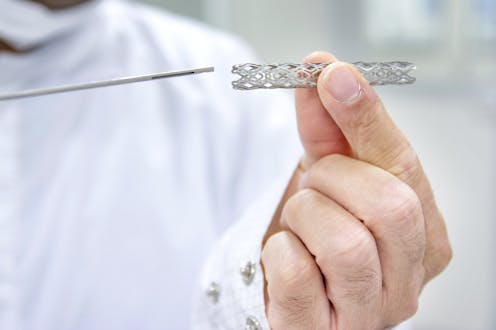
Stents are like scaffolding that keep narrowed arteries open. These devices have been revolutionary in treating heart attacks where their use has increased year on year and countless lives have been saved. But the role of stents in patients with stable angina is less clear.
Heart arteries are like motorways supplying blood to the heart muscle. When a heart artery is narrowed by atherosclerosis it is like reducing the number of lanes from three down to one. At night, when there aren’t many cars on the road, the traffic can get through without delay. But during rush hour, when there are greater demands on the network (an analogy for exercise), traffic jams occur. This explains why patients with stable angina only get chest pain when they exert themselves.
About 35,000 patients a year are treated with stenting of the heart arteries to treat angina, yet several trials have shown that in patients with stable angina, stenting does not provide any reduction in death or heart attack rates over treatment with tablets. Nice guidelines (evidence-based recommendations for healthcare in England) therefore recommend that stenting is reserved for patients who still have symptoms despite treatment with at least two different angina drugs.
Many cardiologists have wondered if that approach is correct as many patients report a dramatic reduction in angina after stenting.
The results of the Orbita study, published in 2017, sent shockwaves through the cardiology world. It introduced the concept that much of the benefit from stenting was a placebo effect.
In the study, patients with angina were randomly assigned to either real or sham stenting. Both groups continued to take their angina medication throughout the trial.
During the sham stenting procedure, patients wore headphones playing loud music and were sedated. At the end of the procedure, the patients had no idea whether they had been treated with a stent or sham. The unexpected result was that in patients taking angina drugs with stenting did not result in extra symptom relief. This raised an unthinkable question: was the symptomatic benefit from coronary stents just a placebo effect?
Now, the results of Orbita-2 have been published in the New England Journal of Medicine. It was a randomised trial of 301 patients, in which patients with angina were randomly allocated to be treated with either real or sham stenting procedure. The big difference between the first Orbita study and this one was that the medical treatment of angina was stopped.
More than just a placebo effect
The results were conclusive that coronary stenting, when used without angina tablets, leads to improvements in angina symptoms and quality of life. This result was a relief to interventional cardiologists around the world, showing that stents did offer more than a placebo.
But before we throw away all the angina tablets and reach for the angioplasty catheters, there are a few cautions about the results of Orbita-2.
Patients who received a stent were able to exercise on a treadmill for 59 seconds longer than those who had the sham procedure. Those who underwent the sham procedure still managed to exercise for over ten minutes, so this effect can be considered modest at best.

Many cardiologists have seen cases of patients crippled by angina who have a spectacular response to stenting and are back running or cycling almost immediately. However, this was not the case for most patients in Orbita-2 who had an increase in only 10% of treadmill exercise time.
You would imagine that fixing the narrowing with a stent would “cure” angina, but this was not the case in most patients. Despite having nearly all coronary narrowing treated by stents, 60% of patients in Orbita-2 still had residual angina and would end up needing to take angina tablets.
This result suggests that the mechanisms of angina are more complex than the single-lane motorway analogy presented earlier. In many patients, even after successful stenting, many are left with some symptoms or needing angina tablets.
Many would argue that despite the new evidence from Orbita-2, the strategy of tablets first is still preferable. Stenting carries a small risk of serious complications, needs patients to take blood-thinning medications and is expensive.
Also, the 59-second increase in exercise time is similar to that which can be achieved with a full dose of a single angina tablet.
Congratulations to the authors of Orbita-2, for conducting a trial that has forced cardiologists to take a deep look at how we treat patients with stable angina. It has shown coronary stenting to be an effective treatment, but for many patients the strategy of tablets first, stents second will still be appropriate and successful.
Peter Swoboda receives funding from British Heart Foundation and Heart Research UK.
This article was originally published on The Conversation. Read the original article.







